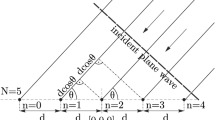Abstract
Based on the Complex Orthogonal Linear Dispersion (COLD) code, a novel linear Differential Space-Time Modulation (DSTM) design is proposed in this paper. Compared with the existing nonlinear DSTM schemes based on group codes, the proposed linear DSTM scheme is easier to design, enjoys full diversity and allows for a simplified differential receiver, which can detect the transmitted symbols separately. Furthermore, compared with the existing linear DSTM based on orthogonal design, our new construction can be applied to any number of transmit antennas. Similar to other algorithms, the proposed scheme also can be demodulated with or without channel estimates at the receiver, but the performance degrades approximately by 3dB when estimates are not available.
Similar content being viewed by others
References
B. L. Hughes. Differential space-time modulation. IEEE Trans. on Inform. Theory, 46(2000)7, 2567–2578.
B. L. Hughes. Optimal space-time constellations from groups. IEEE Trans. on Inform. Theory, 49(2003)2, 401–410.
B. M. Hochwald, W. Sweldens. Differential unitary space-time modulation. IEEE Trans. on Commun., 48 (2000)12, 2041–2052.
A. Shokrollahi, B. Hassibi, B. M. Hochwald, et al. Representation theory for high-rate multiple-antenna code design. IEEE Trans. on Inform. Theory, 47 (2001)9, 2335–2367.
M. O. Damen, K. A. Meraim, J. C. Belfiore. Diagonal algebraic space-time block codes. IEEE Trans. on Commun., 48(2002)3, 628–636.
P. W. Wolniansky, G. J. Foschini, G. D. Golden, et al. V-BLAST: An architecture for realizing very high data rates over the rich-scattering wireless channel. International Symposium on Signals, Systems and Electronics, Pisa, Italy, Sept. 29, 1998, 295–300.
B. Hassibi, B. Hochwald. High-rate codes that are linear in space and time. IEEE Trans. on Inform. Theory, 48(2002)7, 1804–1824.
R. W. Heath, A. J. Paulraj. Linear dispersion codes for MIMO systems based on frame theory. IEEE Trans. on Signal Processing, 50(2002)10, 2429–2441.
S. M. Alamouti. A simple transmit diversity technique for wireless communications. IEEE J. on Selected Areas in Commun., 16(1998)10, 1451–1458.
V. Tarokh, H. Jafarkhani, A. R. Calderbank. Space-time block codes from orthogonal designs. IEEE Trans. on Inform. Theory, 45(1999)7, 1456–1467.
V. Tarokh, H. Jafarkhani. A differential detection scheme for transmit diversity. IEEE J. on Selected Areas in Commun., 18(2000)7, 1169–1174.
H. Jafarkhani, V. Tarokh. Multiple transmit antenna differential detection from generalized orthogonal designs. IEEE Trans. on Inform. Theory, 47(2001)9, 2626–2631.
W. Zhao, G. Leus, G. B. Giannakis. Orthogonal design of unitary constellations for uncoded and trellis-coded noncoherent space-time systems. IEEE Trans. on Inform. Theory, 50(2004)6, 1319–1327.
V. Tarokh, N. Seshadri, A. R. Calderbank. Space-time codes for high data rate wireless communication: performance analysis and code construction. IEEE Trans. on Inform. Theory, 44(1998)3, 744–765.
Author information
Authors and Affiliations
Corresponding author
Additional information
Supported by the National Natural Science Foundation of China (No.60372055), the National High Technology Research and Development Project of China (No. 2003AA123320), and the National Doctoral Foundation of China (No. 20020698024, No.20030698027).
Communication author: Wang Lei, born in 1977, female, Ph.D. candidate. Dept of Information and Communications Engineering, Xi’an Jiaotong University, Xi’an 710049, China.
About this article
Cite this article
Wang, L., Zhu, S. & Wang, J. A novel linear Differential Space-Time Modulation. J. of Electron.(China) 24, 593–599 (2007). https://doi.org/10.1007/s11767-005-0265-9
Received:
Revised:
Issue Date:
DOI: https://doi.org/10.1007/s11767-005-0265-9




